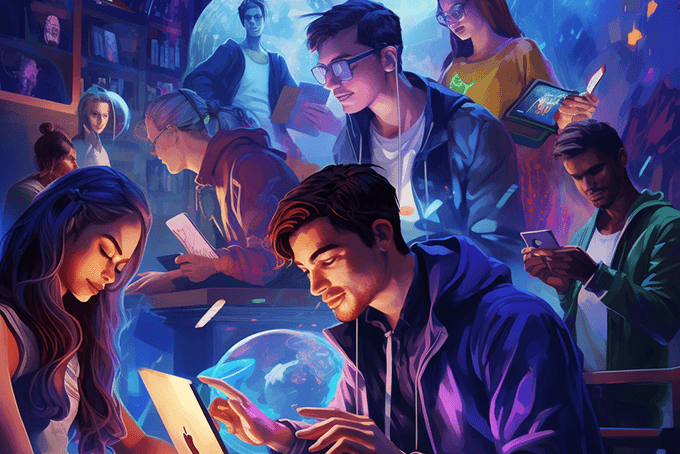Visual learners have unique strengths and challenges when it comes to the learning process. Understanding their needs and implementing effective strategies can make a significant difference in their academic performance and overall learning experience. In this article, we will delve into the science of visual learning, discuss the importance of catering to visual learners, explore effective teaching strategies, highlight the role of technology, and address common challenges faced by visual learners.
Understanding Visual Learning
Visual learning is a learning style characterized by the preference for visual aids and images to understand and retain information. Research has shown that approximately 65% of the population are visual learners. These individuals excel in tasks such as interpreting diagrams, graphs, and charts. They also have a strong ability to visualize concepts and recall visual information.
The Science Behind Visual Learning
Visual learning is rooted in the way our brains process and retain information. The visual cortex, a region in our brain responsible for processing visual stimuli, plays a significant role in this learning style. When visual learners are presented with visual aids, their brains are activated in a way that enhances comprehension and memory retention.
Moreover, studies have indicated that visual learning can lead to deeper understanding and long-term memory recall. By engaging the visual cortex, learners are able to make connections between concepts more effectively, leading to improved learning outcomes.
Identifying Visual Learners in Your Classroom
Recognizing visual learners in your classroom is essential to provide them with the necessary support. Look for signs such as a preference for diagrams and images, strong spatial awareness, and a tendency to take detailed notes during lectures. Additionally, visual learners might struggle with instructions that are solely delivered verbally or with a lack of visual aids in the learning environment.
It’s important to create a learning environment that caters to the needs of visual learners by incorporating visual aids, such as infographics, videos, and mind maps, into your teaching materials. By doing so, you can help visual learners better engage with the content and enhance their learning experience.
The Importance of Catering to Visual Learners
Catering to visual learners is crucial for their academic success and overall engagement in the classroom. When teachers incorporate visual elements into their lessons, they enhance the learning experience for these students and create a more inclusive environment.
Visual learners, often characterized by their preference for images, diagrams, and spatial understanding, make up a significant portion of the student population. Research suggests that approximately 65% of individuals are visual learners, highlighting the importance of adapting teaching methods to accommodate their unique needs. By recognizing and addressing the learning styles of visual learners, educators can optimize the educational experience for a large percentage of their students.
The Impact on Academic Performance
Providing visual learners with appropriate strategies and materials can significantly impact their academic performance. Visual aids facilitate understanding, help with information retention, and improve their ability to organize and analyze information. By catering to their learning needs, teachers can unlock the potential of visual learners and foster higher academic achievement.
Furthermore, studies have shown that visual stimuli can stimulate cognitive processes and enhance critical thinking skills in students. When complex information is presented visually, it can stimulate multiple regions of the brain, leading to deeper comprehension and improved problem-solving abilities. By leveraging the power of visual learning techniques, educators can not only boost academic performance but also cultivate essential skills that are valuable beyond the classroom.
Fostering a More Inclusive Learning Environment
Creating a learning environment that caters to visual learners not only benefits them but also promotes inclusivity for all students. Visual aids help make abstract concepts more tangible, enabling a diverse range of learners to grasp complex ideas more easily. By incorporating visual elements, teachers can support students with different learning styles and enhance the overall learning outcomes of the entire class.
Moreover, embracing visual learning strategies can enhance student engagement and motivation. Visual stimuli have the power to capture students’ attention, spark curiosity, and make learning more interactive and enjoyable. By incorporating visually stimulating materials such as videos, infographics, and interactive presentations, educators can create a dynamic learning environment that resonates with students of all learning preferences, ultimately fostering a culture of active participation and enthusiasm for learning.
Effective Teaching Strategies for Visual Learners
To effectively engage visual learners, teachers can implement various strategies that capitalize on their strengths and preferences. Integrating visual aids, utilizing graphic organizers and diagrams, and employing color coding techniques are essential approaches to consider.
Incorporating Visual Aids in Lessons
Using visual aids such as charts, graphs, and diagrams can greatly enhance comprehension for visual learners. These visual representations provide a clear framework for understanding complex concepts and relationships between ideas. Teachers can employ visual aids in presentations, handouts, and interactive activities to reinforce learning.
For example, when teaching a lesson on the water cycle, a teacher can use a large poster with colorful illustrations to visually depict the different stages of evaporation, condensation, and precipitation. This not only captures the attention of visual learners but also helps them grasp the sequential nature of the water cycle.
Utilizing Graphic Organizers and Diagrams
Graphic organizers and diagrams are powerful tools that help visual learners organize information and improve their understanding. Concepts such as mind maps, Venn diagrams, and concept maps enable them to visually connect different pieces of information and identify patterns and relationships.
When teaching a history lesson, a teacher can provide visual learners with a concept map that outlines the causes, events, and consequences of a particular historical event. This visual representation allows visual learners to see the connections between different factors and gain a deeper understanding of the topic.
The Role of Color Coding in Visual Learning
Color coding is a simple yet effective technique that aids visual learners in organizing and recalling information. By assigning specific colors to different categories or concepts, learners can easily identify and remember key details. Whether it is highlighting, underlining, or utilizing color-coded flashcards, using colors enhances retention and reinforces understanding for visual learners.
For instance, when teaching vocabulary words, a teacher can provide visual learners with flashcards that have each word written in a different color. This allows visual learners to associate specific colors with specific words, making it easier for them to recall and use the vocabulary in context.
In conclusion, incorporating visual aids, utilizing graphic organizers and diagrams, and employing color coding techniques are effective teaching strategies for visual learners. By catering to their visual strengths and preferences, teachers can create a more engaging and inclusive learning environment that supports the academic success of visual learners.
Technology and Visual Learning
The advancement of technology has opened up a myriad of opportunities to enhance visual learning experiences. Digital tools and multimedia platforms offer interactive and engaging resources that cater to visual learners’ needs.
Visual learning is a powerful educational approach that emphasizes the use of images, diagrams, animations, and videos to convey information. By incorporating visual elements into teaching materials, educators can create a more stimulating and effective learning environment for students with diverse learning styles.
Digital Tools for Visual Learning
Various digital tools, such as interactive whiteboards, educational apps, and virtual reality programs, can facilitate visual learning. These tools provide dynamic visual representations that actively engage learners and promote deeper understanding through interactive experiences.
Interactive whiteboards, for example, allow teachers to display visual content in real-time, enabling students to interact directly with the material. Educational apps offer interactive quizzes, games, and simulations that cater to visual learners’ preferences for hands-on learning experiences. Virtual reality programs immerse students in realistic 3D environments, enhancing their visual comprehension and retention of complex concepts.
The Benefits of Video and Multimedia
Video and multimedia have proven to be effective educational resources for visual learners. Visual information presented in the form of videos or interactive multimedia content helps these learners grasp concepts in a more engaging and memorable way. Integrating relevant videos and multimedia resources into lessons can enhance comprehension and promote active learning.
Furthermore, videos and multimedia content can cater to different learning paces and preferences, allowing students to review material at their own speed. By incorporating a variety of visual resources, educators can accommodate the diverse needs of visual learners and create a more inclusive and engaging learning environment.
Overcoming Challenges with Visual Learning
While visual learning offers many benefits, there are unique challenges that visual learners may face. Understanding and addressing these challenges help teachers create a supportive learning environment for all students.
Addressing Common Misconceptions
One common misconception is that visual learners require visual aids at all times. While visual aids are beneficial, it is important to provide a balanced approach that incorporates diverse instructional methods, such as auditory and kinesthetic elements. By addressing this misconception, teachers can ensure that visual learners develop well-rounded skills and adaptability.
Balancing Different Learning Styles in One Classroom
Teachers face the challenge of accommodating various learning styles, including visual, auditory, and kinesthetic preferences. Balancing these different styles requires flexibility and creativity in lesson planning. Incorporating a mix of instructional strategies that cater to different learning styles ensures a comprehensive learning experience for all students.
In conclusion, understanding visual learners and implementing effective strategies can significantly enhance their learning experience. By recognizing visual learners, promoting inclusivity, and employing appropriate teaching techniques, teachers can help these students thrive and achieve their full potential.



